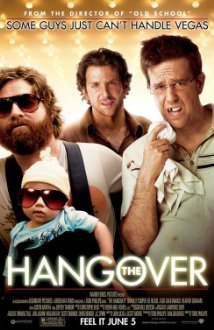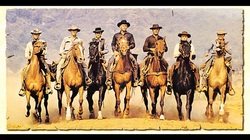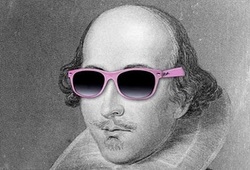
 I was reading comments on Linked In about multiple protagonist films being essentially TV forms and not at present popular and accepted, I'd disagree. I think they are very common in film and have been for many years. Almost every time you see a poster that shows a group of characters together you're looking at a multiple protagonist film. Almost every group mission, siege or reunion film is structured this way - because the point of such stories is that a number of equally interesting individuals are thrown together by the same event and each reacts differently (and interestingly) to each event. These films aren't rarities or art house films. 'The Hangover' series are all multiple protagonist films, as is 'The Full Monty', 'Death at a Funeral', 'Independence Day', all of those 'Cinderella Sports Team' movies and really any movie that could be subtitled 'Let's put on a show' or, in gangster movies. 'One last job' . Most war films are structured this way. I haven't yet seen it but from the sound of it, I imagine 'The Monument Men' is multiple protagonist film. From memory I'd say the Police Academy comedies are also multiple protagonist. Commercially, the great thing about these films is that they normally provide a number of really good roles that attract good actors. As for the idea of considering your multiple protagonist for a TV series instead, it's a good idea, but it'll only work if your premise - what your multiple protagonist group is doing - must be capable of providing many seasons.
0 Comments
 The Magnificent Seven The Magnificent Seven I've been having some correspondence with a writer who has written a film that has multiple storylines and multiple protagonists but been told by a number of people who have read the script to pick a hero or heroine and make the film about just that character. I thought readers might be interested in the issue since it’s one that often comes up. As you’ll all be aware I am a great supporter of films that involve multiple protagonists and multiple storylines. I think scripts are often wrecked because a script that has its interest specifically in being about a group is turned into a story about one of the group - with the other members of the group simply appearing from time to time being, well, colorful. This is a bit like turning the The Full Monty into a story about one man putting on a striptease show not a group, or perhaps making The Magnificent Seven into The Magnificent One. Some stories are about groups, full stop, and they won’t work with a ‘one hero’ structure. But films that use multiple storylines each with their own protagonist are not always the answer. Many fine films consist only of one hero on a single linear chronological journey. It depends on the story you want to tell. Content dictates structure. If you do decide to use multiple storylines (and there are many different types of structure that will permit you do that ) you will hit all kinds of challenges. These include the need to have connections between your storylines (or your audience will rightly be asking ‘what is all this about? Why these characters and no others?’) and you will always have a battle to create and maintain pace, meaning, closure and how and when to jump between stories - simply because all parallel narrative scripts do. It’s the nature of the beast. But there are many types of multiple storyline structure Note that I said there that there are many types of structures that use multiple storylines and multiple protagonists, not just one. For example, Pulp Fiction has multiple storylines and multiple characters but it's structured very differently from The Full Monty or Traffic, both of which also have multiple storylines and protagonists. This is an important point to remember because conventional screenwriting theory lumps together all types of film that don't fit the one-hero-on-a-single-chronological journey. They are clearly not all the same. I stress, the plotting and character problems in a film like Nashville are completely different from such problems in a film like Pulp Fiction. In The 21st Century Screenplay I have isolated six categories with many subcategories (for example, there are many different types of flashback). But meanwhile, hybrids are appearing all the time and we must expect more. Screenwriting structures are diversifying all the time. Here is what the writer said: Writer to Linda
Linda's reply Sticking to your guns... First of all I’d say don’t stick to your guns about anything before you’re very sure that the people picking the problems are wrong. Maybe they’re right and you do need a one hero storyline because the story material is really mostly about one character. Alternatively, assuming that what you are intending to transmit does require a group of characters, maybe your readers have picked inadequacies in the way you are creating your group story but are offering the wrong solution. Very often when people tell a writer to focus on one hero and not the group it’s a case of there being something wrong with the multiple protagonist script but the wrong solution is being offered. Perhaps your multiple protagonist films is indeed coming over as characters in search of a plot and you need to invent a plot that unites and explains them. Maybe there is, generally, insufficient connection between the storylines so that they feel random. Maybe you are just not getting what’s in your head on to the page. You are certainly not convincing your readers that your film is at present holding together as you feel it is. I was given this very good piece of advice many years ago by a very good and very experienced producer: ‘If one reader thinks there’s a problem, it might be just their idiosyncratic view. If two people have the same problem, sit up and listen. If three readers have the same problem you have some fixing to do’ 'Logically impossible to please all readers?' The writer says: Each person that's read script identifies with a different character according to (reader's) gender, sexuality, colour, educational/cultural values & personal/sexual prudery = for me this is a positive, it's what I aimed for. Ergo it's logically impossible for me to 'please' all readers. I'd say - not necessarily. If the characters are sufficiently connected and all contribute towards an interesting message you may be able to please them all. They are clearly not pleased at the moment, so you have a choice either to dismiss their opinion and seek another audience or to do something to make them enjoy the script. Not one main protagonist The writer adds There isn't ONE main protagonist - each character/character's storyline is strong enough for a film in its own right = for me a positive. Fine! Lots of great films have multiple storylines and multiple protagonists, but there needs to be a connection between them that answers the question: ‘why these six characters and not another six characters?’or your audience will get restless and irritated. They will be asking (and who can blame them?) 'Why these characters? What’s the connection? What’s the intention of the film?' Is the writer confusing multiple protagonist form with tandem narrative structure? I haven't read the script, but the more I look at the writer's comment that 'each character/character's storyline is strong enough for a film in its own right' the more I think the writer might be confusing what I term 'multiple protagonist form' (which is about a group of characters on a joint 'adventure' which is either a quest, a reunion or a siege, social or physical) and another sort of group story which I've termed tandem narrative, which also has multiple storylines, each with its own protagonist, but which is very different and needs handling in a very different way. What is tandem narrative? I've explained this as 'equally important storylines running together in tandem in the same time frame on the same theme'. It's the form of films like Traffic or Nashville, where characters have separate storylines – rather than being involved together in a joint quest, siege or reunion. Tandem films follow individual characters off on their own journeys. Sometimes these characters don't even know each other. From the sound of things I think the script is a tandem narrative. But I think the writer might be trying to think of this according to the guidelines I've set out for multiple protagonist form, which don't apply. I'll discuss this further later. First let's look at the issue of connection in these films. Connection in Multiple Storyline films, Whether you're using tandem narrative or multiple protagonist narrative (or any other kind of parallel narrative for that matter) it's not enough simply to have fascinating characters. From the audience’s point of view the issue is not that the characters are each individually fascinating. It’s why the filmmakers have put these particular characters together in a film. The audience questions are, as I've said : ‘why these characters and no others?’ ‘What is the connection?’ ‘What is the intention behind the film?’ And crucially: 'Why am I sitting here watching this?’ If there is no proper connection, people will feel resentful. For example, many people reject the film Babel out of hand because they felt the Japanese girl’s story was insufficiently connected to the others. No matter that they loved the rest of the film. Babel by the way is in the form I've termed a 'fractured tandem' film, that is, it has equally important stories on the same theme but is fractured. How to make connections in tandem narrative films Tandem films are normally connected by a theme. For example, a simple type of connection in film about six people having very separate adventures would be something like: all six are versions of ‘a bizarre person living in London’ with the theme being: ‘bizarreness in all its forms is difficult to cope with but is something we need in this world’. Typically in these films connections are made in some or even all of the following ways. 1. connections through date (e.g. six differently bizarre people are having their separate adventures in London on the same day ) 2. through place (e.g. six differently bizarre people are having their separate adventures in the same part of London on the same day) 3. through an object (e.g six differently bizarre people are having their separate adventures in the same part of London on the same day and they all, one after the other, sit in the same seat on the same bus as it travels its designated route up a major road in their area). 4. connections through plotlines – that is, characters might appear in more than one storyline. 5. conections through a 'Macro Plot'. There is often what I call a macro plot, that is, an umbrella plot line on the same theme as all of the other stories, but one that links all of the differently bizarre characters together physically AND by theme. For example London is blanketed by a terrible fog (symbolic of the confusion and anonymizing aspects of city life which makes us need more bizarreness in our lives), that is causing pneumonia and traffic accidents to the populace, including the bizarre characters. The writer concludes I will however fight with myself to form a character hierarchy & see what that brings forth... My issue is character democracy Let's pause here. You're not being asked to create a character hierarchy. This comment is another reason that I feel you might be getting confused with multiple protagonist form, in which you have a range of different version of the same type of protagonist, including what I've called 'the instigator', that is, the protagonists who causes the story. The instigator in the multiple protagonist film The Full Monty is the Robert Carlyle character, the man who has the idea of the striptease. I'd say your issue is to explain what is similar about your characters, why they have not been chosen at random. Regarding 'character democracy' I think you have to ask yourself here: ‘to what end?’ What is your intention in putting these particular characters into a film together? Sometimes it helps with this sort of thing to ask yourself what the audience is supposed to be thinking and feeling and discussing when they leave the cinema. Sometimes this can clarify your intentions. Or is it consecutive stories form? There are, as often happens in these parallel narrative forms, different ways to tell our story. We could, for example, tell the stories of our six differently bizarre characters in yet another way. Let's imagine we use the idea of each of the six using the same bus seat on the same day. You could construct the film by following each of the characters in turn off the bus and into their own story. Once that story is complete or semi-complete, you could return to the bus with the next bizarre character getting on. You'd then somehow unite the characters at the end. That structure would be a form I've given the name of 'consecutive stories'. You can have that in simple or fractured forms. My hunch is that our writer is thinking of a tandem narrative structure. But do you need to invent a hybrid? More and more I'm being asked to help with complex film scripts that are blending different types of parallel narrative. You may need to create your own particular hybrid. How to do this? I'd suggest you start by looking at what I've isolated, checking my guidelines in The 21st Century Screenplay and seeing how you can merge them, always keeping an eye on pace, connection, meaning and closure. That is usually a lot of help. After that, unfortunately, you are on your own. Writing alas isn't easy. Ever wondered why top writers can command such large sums? You get the picture. To sum up... In conclusion, for anyone wrestling with this sort of problem, I suggest checking out first the many articles on this site under the tab Practical Writing Advice then look at my chapters in The 21st Century Screenplay on parallel narrative, particularly the chapters on Tandem Narrative and Multiple Protagonist narrative. These explain what plot and character components work in successful films of each kind. Also read the section in that book entitled 'Lost in the Telling'. This includes discussion of Multiple Protagonist and Tandem films that don't work - and crucially, why.Make doubly sure that you have chosen the particular structure that suits the story you want to tell.  I recently wrote the post below entitled Ten Ways the Conventional Hollywood three act one hero Chronological Structure will let you down. A filmmaker responded: ‘It worked for William Shakespeare’. Of course everyone is entitled to their own opinions, but I feel this is inaccurate, and since those of who write drama need to take old Bill very seriously indeed, I responded in detail, explaining that Shakespeare used multiple storylines, not just one and even flashback (in Henry V), his structure being similar to what we see in films like Nashville and Traffic and in many TV series and serials (which I suspect inherited their structure from the stage). I thought you might be interested. And by the way, always feel free to correct or challenge my ideas. Convince me and I'll change 'em. Here's the post With respect I believe this to be inaccurate, but I'm happy to be corrected. Shakespeare's plays are all, famously, in five acts, but even if we leave that formality of structure aside, Shakespeare's plays to the best of my knowledge, all have multiple plotlines, not just one hero on a single journey, although each of those multiple storylines is usually, I think, a three act structure. Shakespeare's plays utilise a very similar multiple storyline structure to the one used in films like 'Traffic' or 'Nashville' (a structure that I have I have termed 'tandem narrative' meaning 'stories running together') which is a structure involving a number of equally important stories on the same theme. In this, you have multiple storylines linked by: theme; often (but not always) geography; and characters that appear in several different storylines. A lot of TV drama is structured like this, too, with multiple separate plotlines, hence the irritation of experienced TV writers when they're told linear one hero structure is the only way.. Shakespeare's comedies, like all Elizabethan/Jacobean comedies, famously have three plot lines, not just one, featuring three separate couples with stories on the same theme. Having three couples in a comedy was actually a convention of English comedy writing at the time, there being also a dance featuring all six together at the end of the play. 'Henry V' famously features what I've termed a bookend flashback structure (where a character in the present appears and talks about the past - or is reminded by it - and we flash back ('this wooden 0") . When we're in the past in Henry V, there are several storylines there. The tragedies have several plotlines on the same theme (eg King Lear has the Gloucester/Edgar/Edmund storyline on the same theme as that of Lear, namely 'ungrateful/grateful child' but note that Lear himself appears in it only at the start ). Also, while it is currently fashionable to assert that all great drama is based on the Aristotelian notion of unities of time and place and single plotline, Shakespeare was famous for not fitting this model. There was a huge debate about this in the eighteenth century, in which Racine I believe and the French neoclassicists rejected Shakespeare as a bad playwright) However, Dr Johnson wrote a famous piece arguing that Shakespeare transcended Aristotle's formulae. So the 'Aristotelian structure is the only one' argument was put to bed two centuries ago. And, of course, French neoclassic drama famously atrophied and died out because it was so rule bound). But that's a whole other issue. Happy to be corrected if Shakespeare did write any plays that featured solely one hero in one chronological three storyline. For more information on my theories go first to Practical Writing Advice on my website then read my book The 21st Century Screenplay. And there are also videos of me, some free, one, a two hour lecture, for purThis nonlinear multiple storyline stuff isn't easy, but it's doable. (and that witty pic of Shakespeare is from the very clever Slatebreakers site) |
AuthorLinda is a screenwriter, novelist and playwright. As well as teaching and mentoring writers around the world, she regularly consults on screenplays at the highest level in the US, UK and Australia. Subscribe to Linda Aronson's Craft Skills NewsletterArchives
June 2017
Categories
All
Note: Hi everyone. For RSS feed from this blog, you'll need feedly.com or theoldreader.com. Thanks, Linda
|
 RSS Feed
RSS Feed


